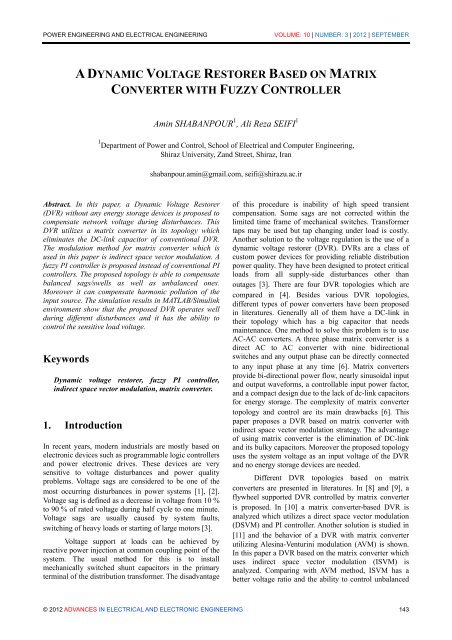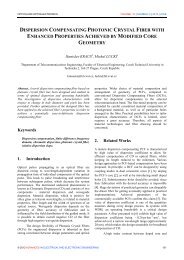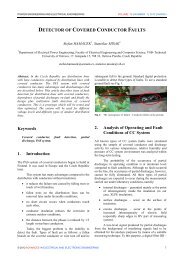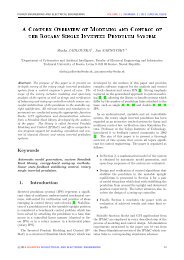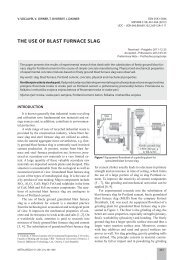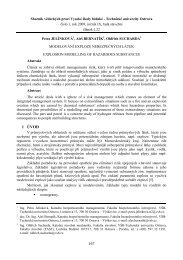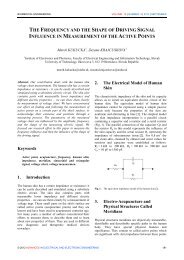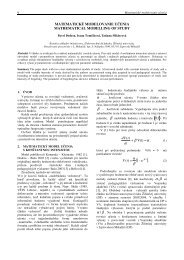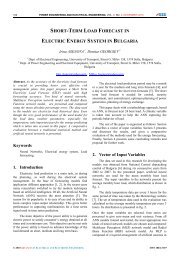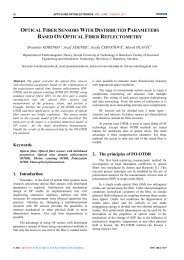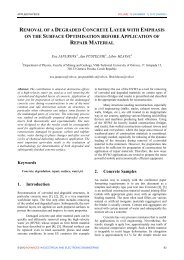A Dynamic Voltage Restorer based on Matrix Converter with Fuzzy ...
A Dynamic Voltage Restorer based on Matrix Converter with Fuzzy ...
A Dynamic Voltage Restorer based on Matrix Converter with Fuzzy ...
You also want an ePaper? Increase the reach of your titles
YUMPU automatically turns print PDFs into web optimized ePapers that Google loves.
POWER ENGINEERING AND ELECTRICAL ENGINEERING<br />
VOLUME: 10 | NUMBER: 3 | 2012 | SEPTEMBER<br />
A DYNAMIC VOLTAGE RESTORER BASED ON MATRIX<br />
CONVERTER WITH FUZZY CONTROLLER<br />
Amin SHABANPOUR 1 , Ali Reza SEIFI 1<br />
1 Department of Power and C<strong>on</strong>trol, School of Electrical and Computer Engineering,<br />
Shiraz University, Zand Street, Shiraz, Iran<br />
shabanpour.amin@gmail.com, seifi@shirazu.ac.ir<br />
Abstract. In this paper, a <str<strong>on</strong>g>Dynamic</str<strong>on</strong>g> <str<strong>on</strong>g>Voltage</str<strong>on</strong>g> <str<strong>on</strong>g>Restorer</str<strong>on</strong>g><br />
(DVR) <strong>with</strong>out any energy storage devices is proposed to<br />
compensate network voltage during disturbances. This<br />
DVR utilizes a matrix c<strong>on</strong>verter in its topology which<br />
eliminates the DC-link capacitor of c<strong>on</strong>venti<strong>on</strong>al DVR.<br />
The modulati<strong>on</strong> method for matrix c<strong>on</strong>verter which is<br />
used in this paper is indirect space vector modulati<strong>on</strong>. A<br />
fuzzy PI c<strong>on</strong>troller is proposed instead of c<strong>on</strong>venti<strong>on</strong>al PI<br />
c<strong>on</strong>trollers. The proposed topology is able to compensate<br />
balanced sags/swells as well as unbalanced <strong>on</strong>es.<br />
Moreover it can compensate harm<strong>on</strong>ic polluti<strong>on</strong> of the<br />
input source. The simulati<strong>on</strong> results in MATLAB/Simulink<br />
envir<strong>on</strong>ment show that the proposed DVR operates well<br />
during different disturbances and it has the ability to<br />
c<strong>on</strong>trol the sensitive load voltage.<br />
Keywords<br />
<str<strong>on</strong>g>Dynamic</str<strong>on</strong>g> voltage restorer, fuzzy PI c<strong>on</strong>troller,<br />
indirect space vector modulati<strong>on</strong>, matrix c<strong>on</strong>verter.<br />
1. Introducti<strong>on</strong><br />
In recent years, modern industrials are mostly <str<strong>on</strong>g>based</str<strong>on</strong>g> <strong>on</strong><br />
electr<strong>on</strong>ic devices such as programmable logic c<strong>on</strong>trollers<br />
and power electr<strong>on</strong>ic drives. These devices are very<br />
sensitive to voltage disturbances and power quality<br />
problems. <str<strong>on</strong>g>Voltage</str<strong>on</strong>g> sags are c<strong>on</strong>sidered to be <strong>on</strong>e of the<br />
most occurring disturbances in power systems [1], [2].<br />
<str<strong>on</strong>g>Voltage</str<strong>on</strong>g> sag is defined as a decrease in voltage from 10 %<br />
to 90 % of rated voltage during half cycle to <strong>on</strong>e minute.<br />
<str<strong>on</strong>g>Voltage</str<strong>on</strong>g> sags are usually caused by system faults,<br />
switching of heavy loads or starting of large motors [3].<br />
<str<strong>on</strong>g>Voltage</str<strong>on</strong>g> support at loads can be achieved by<br />
reactive power injecti<strong>on</strong> at comm<strong>on</strong> coupling point of the<br />
system. The usual method for this is to install<br />
mechanically switched shunt capacitors in the primary<br />
terminal of the distributi<strong>on</strong> transformer. The disadvantage<br />
of this procedure is inability of high speed transient<br />
compensati<strong>on</strong>. Some sags are not corrected <strong>with</strong>in the<br />
limited time frame of mechanical switches. Transformer<br />
taps may be used but tap changing under load is costly.<br />
Another soluti<strong>on</strong> to the voltage regulati<strong>on</strong> is the use of a<br />
dynamic voltage restorer (DVR). DVRs are a class of<br />
custom power devices for providing reliable distributi<strong>on</strong><br />
power quality. They have been designed to protect critical<br />
loads from all supply-side disturbances other than<br />
outages [3]. There are four DVR topologies which are<br />
compared in [4]. Besides various DVR topologies,<br />
different types of power c<strong>on</strong>verters have been proposed<br />
in literatures. Generally all of them have a DC-link in<br />
their topology which has a big capacitor that needs<br />
maintenance. One method to solve this problem is to use<br />
AC-AC c<strong>on</strong>verters. A three phase matrix c<strong>on</strong>verter is a<br />
direct AC to AC c<strong>on</strong>verter <strong>with</strong> nine bidirecti<strong>on</strong>al<br />
switches and any output phase can be directly c<strong>on</strong>nected<br />
to any input phase at any time [6]. <strong>Matrix</strong> c<strong>on</strong>verters<br />
provide bi-directi<strong>on</strong>al power flow, nearly sinusoidal input<br />
and output waveforms, a c<strong>on</strong>trollable input power factor,<br />
and a compact design due to the lack of dc-link capacitors<br />
for energy storage. The complexity of matrix c<strong>on</strong>verter<br />
topology and c<strong>on</strong>trol are its main drawbacks [6]. This<br />
paper proposes a DVR <str<strong>on</strong>g>based</str<strong>on</strong>g> <strong>on</strong> matrix c<strong>on</strong>verter <strong>with</strong><br />
indirect space vector modulati<strong>on</strong> strategy. The advantage<br />
of using matrix c<strong>on</strong>verter is the eliminati<strong>on</strong> of DC-link<br />
and its bulky capacitors. Moreover the proposed topology<br />
uses the system voltage as an input voltage of the DVR<br />
and no energy storage devices are needed.<br />
Different DVR topologies <str<strong>on</strong>g>based</str<strong>on</strong>g> <strong>on</strong> matrix<br />
c<strong>on</strong>verters are presented in literatures. In [8] and [9], a<br />
flywheel supported DVR c<strong>on</strong>trolled by matrix c<strong>on</strong>verter<br />
is proposed. In [10] a matrix c<strong>on</strong>verter-<str<strong>on</strong>g>based</str<strong>on</strong>g> DVR is<br />
analyzed which utilizes a direct space vector modulati<strong>on</strong><br />
(DSVM) and PI c<strong>on</strong>troller. Another soluti<strong>on</strong> is studied in<br />
[11] and the behavior of a DVR <strong>with</strong> matrix c<strong>on</strong>verter<br />
utilizing Alesina-Venturini modulati<strong>on</strong> (AVM) is shown.<br />
In this paper a DVR <str<strong>on</strong>g>based</str<strong>on</strong>g> <strong>on</strong> the matrix c<strong>on</strong>verter which<br />
uses indirect space vector modulati<strong>on</strong> (ISVM) is<br />
analyzed. Comparing <strong>with</strong> AVM method, ISVM has a<br />
better voltage ratio and the ability to c<strong>on</strong>trol unbalanced<br />
© 2012 ADVANCES IN ELECTRICAL AND ELECTRONIC ENGINEERING 143
POWER ENGINEERING AND ELECTRICAL ENGINEERING<br />
VOLUME: 10 | NUMBER: 3 | 2012 | SEPTEMBER<br />
voltages. The advantage of ISVM over DSVM is the<br />
simplicity of implementati<strong>on</strong>. One disadvantage of PI<br />
c<strong>on</strong>troller is using fixed gains which may cause the<br />
c<strong>on</strong>troller not to provide the suitable performance<br />
specially when there are variati<strong>on</strong>s in system parameters<br />
or operating c<strong>on</strong>diti<strong>on</strong>s. To overcome this problem, a PI<br />
c<strong>on</strong>troller utilizing fuzzy logic algorithm is used instead<br />
of the simple PI c<strong>on</strong>troller. The fuzzy algorithm can<br />
adjust the value of the two gains in the PI c<strong>on</strong>troller in<br />
order to make a better resp<strong>on</strong>se to the system operating<br />
point variati<strong>on</strong>s.<br />
In this paper, the proposed DVR structure is<br />
introduced in Secti<strong>on</strong> 2. Indirect space vector modulati<strong>on</strong><br />
for matrix c<strong>on</strong>verters is reviewed in Secti<strong>on</strong> 3, followed<br />
by fuzzy c<strong>on</strong>trol strategy of DVR in Secti<strong>on</strong> 4. Typical<br />
system simulati<strong>on</strong>s and numerical results via<br />
MATLAB/Simulink software are presented in Secti<strong>on</strong> 5.<br />
In Secti<strong>on</strong> 6, the c<strong>on</strong>venti<strong>on</strong>al PI c<strong>on</strong>troller is compared<br />
<strong>with</strong> the proposed fuzzy PI c<strong>on</strong>troller. Finally, Secti<strong>on</strong> 7<br />
c<strong>on</strong>cludes the discussi<strong>on</strong>.<br />
2. DVR Topology<br />
The main functi<strong>on</strong> of a DVR is voltage injecti<strong>on</strong> to<br />
compensate the voltage drop due to the voltage sag<br />
occurrence. In the other word DVR restores the load<br />
voltage to its rated value. To do this, DVR needs to<br />
exchange active and reactive power <strong>with</strong> the system.<br />
There are two types of DVR in general: 1) DVR <strong>with</strong> no<br />
energy storage system, 2) DVR <strong>with</strong> energy storage<br />
system. Each type has two topologies: 1) supply-sidec<strong>on</strong>nected<br />
c<strong>on</strong>verter, and 2) load-side-c<strong>on</strong>nected<br />
c<strong>on</strong>verter. All of the menti<strong>on</strong>ed topologies are compared<br />
in [4] and the no energy storage DVR topology <strong>with</strong> loadside-c<strong>on</strong>nected<br />
c<strong>on</strong>verter has been evaluated as the best<br />
<strong>on</strong>e which is shown in Fig. 1.<br />
which means a DVR <strong>with</strong> no energy storage and loadside<br />
c<strong>on</strong>nected c<strong>on</strong>verter. According to Fig. 1 two<br />
c<strong>on</strong>verters are replaced by a matrix c<strong>on</strong>verter and the DClink<br />
capacitor is removed. Figure 2 shows the resultant<br />
DVR system.<br />
Fig. 2: <strong>Matrix</strong> c<strong>on</strong>verter <str<strong>on</strong>g>based</str<strong>on</strong>g> DVR.<br />
The input voltage of matrix c<strong>on</strong>verter comes from<br />
the load and the output of matrix c<strong>on</strong>verter is c<strong>on</strong>nected<br />
to an injecti<strong>on</strong> transformer. <strong>Matrix</strong> c<strong>on</strong>verter c<strong>on</strong>trols the<br />
required compensati<strong>on</strong> voltage and injects that voltage<br />
through the transformer. To reduce harm<strong>on</strong>ics, both input<br />
and output of matrix c<strong>on</strong>verter are supplied <strong>with</strong> filters.<br />
There is no energy storage device and the energy is taken<br />
from the grid.<br />
3. Indirect Space Vector Modulati<strong>on</strong><br />
for <strong>Matrix</strong> C<strong>on</strong>verters<br />
<strong>Matrix</strong> C<strong>on</strong>verter is made up of nine bi-directi<strong>on</strong>al<br />
switches arranged in an array of in such a way as to<br />
enable any input phase to be c<strong>on</strong>nected to any output<br />
phase at any time (Fig. 3). The switch duty cycles are<br />
modulated to produce desired output voltage from the<br />
supply voltage. There are various modulati<strong>on</strong> techniques<br />
such as Venturini modulati<strong>on</strong>, Optimum Venturini<br />
modulati<strong>on</strong>, and Space Vector modulati<strong>on</strong>s (SVM). The<br />
last <strong>on</strong>e has two types: direct SVM, and indirect SVM<br />
which is utilized in this paper.<br />
Fig. 1: General Type of DVR <strong>with</strong> no energy storage and load-sidec<strong>on</strong>nected<br />
c<strong>on</strong>verter.<br />
As there is no energy storage device in this<br />
topology, DVR needs a minimum system voltage to work<br />
properly and it may not be able to compensate very deep<br />
sags but the lack of energy storage device is a great<br />
ec<strong>on</strong>omical advantage. Furthermore, most usual sags are<br />
<strong>with</strong>in the range of DVR limits. The matrix c<strong>on</strong>verter<br />
<str<strong>on</strong>g>based</str<strong>on</strong>g> DVR in this paper is established <strong>on</strong> this topology<br />
Fig. 3: <strong>Matrix</strong> c<strong>on</strong>verter topology.<br />
In indirect method, matrix c<strong>on</strong>verter is modeled as<br />
two stage back-to-back c<strong>on</strong>verter: a rectificati<strong>on</strong> stage to<br />
create an imaginary DC link voltage, and an inverter<br />
© 2012 ADVANCES IN ELECTRICAL AND ELECTRONIC ENGINEERING 144
POWER ENGINEERING AND ELECTRICAL ENGINEERING<br />
VOLUME: 10 | NUMBER: 3 | 2012 | SEPTEMBER<br />
stage to provide the required three-phase output voltage<br />
[12]. Figure 4 shows the equivalent model for the indirect<br />
space vector modulati<strong>on</strong>.<br />
Fig. 4: Equivalent circuit of matrix c<strong>on</strong>verter for indirect space vector<br />
modulati<strong>on</strong>.<br />
The switching functi<strong>on</strong> in a matrix c<strong>on</strong>verter is as<br />
follows:<br />
where:<br />
V<br />
S 11<br />
S<br />
21<br />
S <br />
31<br />
V <br />
A <br />
<br />
a <br />
V <br />
B<br />
S 12<br />
S<br />
22<br />
S <br />
32<br />
V , (1)<br />
<br />
b<br />
<br />
V C S 13<br />
S<br />
23<br />
S<br />
33<br />
V<br />
<br />
<br />
c<br />
<br />
<br />
I S 11<br />
S<br />
12<br />
S <br />
13<br />
I <br />
a A <br />
I <br />
b<br />
S 21<br />
S<br />
22<br />
S <br />
23<br />
I <br />
B<br />
, (2)<br />
<br />
I S I<br />
c<br />
<br />
31<br />
S<br />
32<br />
S<br />
33<br />
<br />
C <br />
<br />
1 S : Close<br />
<br />
S<br />
<br />
<br />
0 S<br />
<br />
: Open<br />
<br />
1, 2, 3 , 1, 2, 3<br />
. (3)<br />
The c<strong>on</strong>trol algorithm of indirect matrix c<strong>on</strong>verter<br />
is <str<strong>on</strong>g>based</str<strong>on</strong>g> <strong>on</strong> separating this switching functi<strong>on</strong> into the<br />
product of a rectifier and an inverter switching functi<strong>on</strong>:<br />
S11 S21 S31 S7 S8<br />
<br />
S1 S3 S5<br />
S12 S22 S<br />
<br />
32 S9 S<br />
<br />
<br />
<br />
10 . (4)<br />
S2 S4 S<br />
<br />
6<br />
S13 S23 S33 S11 S <br />
<br />
<br />
<br />
12 <br />
There are two modulati<strong>on</strong>s which should be<br />
implemented: a current source rectifier space vector<br />
modulati<strong>on</strong> and a voltage source inverter space vector<br />
modulati<strong>on</strong>.<br />
3.1. Rectifier stage modulati<strong>on</strong><br />
<br />
2<br />
I i ai a i I<br />
3<br />
2<br />
in a b c mi<br />
a e<br />
2<br />
j<br />
3<br />
<br />
. (5)<br />
Figure 5 shows that I in is synthesized using two<br />
adjacent vectors I γ and I δ <strong>with</strong> duty cycles d γ and d δ ,<br />
respectively which are defined as:<br />
T<br />
<br />
<br />
d<br />
mcsin i<br />
T<br />
<br />
3<br />
<br />
<br />
. (6)<br />
d<br />
<br />
s<br />
T<br />
mcsin i. (7)<br />
T<br />
s<br />
In these equati<strong>on</strong>s, the current modulati<strong>on</strong> index is<br />
m c =I m /i p and i p is the DC link current which is shown in<br />
Fig. 4. The zero vector duty cycle is:<br />
0c<br />
1<br />
<br />
<br />
d d d . (8)<br />
Then I in is as follows:<br />
I d I d I d I . (9)<br />
in<br />
<br />
<br />
<br />
0c<br />
0<br />
The average voltage of the DC-link, V avg pn , which<br />
is generated by rectificati<strong>on</strong> stage, can be determined<br />
using the following equati<strong>on</strong>:<br />
avg 3 Peak<br />
Vpn Vin mc cosi<br />
. (10)<br />
2<br />
Fig. 5: Input current space vector.<br />
3.2. Inverter stage modulati<strong>on</strong><br />
The inversi<strong>on</strong> stage space vector, V out , is defined as:<br />
The input current space vector may be defined as:<br />
© 2012 ADVANCES IN ELECTRICAL AND ELECTRONIC ENGINEERING 145
POWER ENGINEERING AND ELECTRICAL ENGINEERING<br />
VOLUME: 10 | NUMBER: 3 | 2012 | SEPTEMBER<br />
<br />
2<br />
V V aV a V V<br />
3<br />
2<br />
out A B C mv<br />
a e<br />
2<br />
j<br />
3<br />
<br />
. (11)<br />
Similar approach is taken to synthesize this vector as<br />
shown in Fig. 6. Duty cycles in this stage are:<br />
T<br />
<br />
<br />
d<br />
mvsin v<br />
T<br />
<br />
3<br />
<br />
<br />
. (12)<br />
d<br />
<br />
s<br />
T<br />
mvsin v. (13)<br />
T<br />
s<br />
d0v<br />
1 d<br />
d<br />
<br />
. (14)<br />
where m v =√3V m /V pn is the voltage modulati<strong>on</strong><br />
index and V pn indicates the DC link voltage which is<br />
shown in Fig. 4. So V out can be written as:<br />
Vout<br />
dV dV<br />
d0vV0 . (15)<br />
which is used in this paper is shown in Fig. 7 where:<br />
T d . T ; T<br />
xy xy s s<br />
y <br />
x , , ,<br />
<br />
1<br />
<br />
f . (21)<br />
and f s is switching frequency of the modulati<strong>on</strong>.<br />
Fig. 7: Symmetrical double-sided switching pattern for indirect space<br />
vector modulati<strong>on</strong>.<br />
4. C<strong>on</strong>trol Strategy of DVR<br />
PI c<strong>on</strong>trollers are widely used in many electrical<br />
applicati<strong>on</strong>s. One reas<strong>on</strong> is its simplicity. The other<br />
reas<strong>on</strong> is the ability to c<strong>on</strong>trol the steady state error of the<br />
system. The disadvantage of c<strong>on</strong>venti<strong>on</strong>al PI c<strong>on</strong>trollers<br />
is its fix gains which makes it unable to c<strong>on</strong>trol the<br />
transient resp<strong>on</strong>se of the system in abnormal c<strong>on</strong>diti<strong>on</strong>s<br />
[13]. One soluti<strong>on</strong> is using an adaptive c<strong>on</strong>troller to adopt<br />
the PI c<strong>on</strong>troller gains in real-time. Figure 8 shows a<br />
fuzzy PI c<strong>on</strong>troller. One feature of fuzzy algorithm is that<br />
it doesn’t need a mathematical model of the system.<br />
s<br />
<br />
Fig. 8: <strong>Fuzzy</strong> PI c<strong>on</strong>troller structure.<br />
Fig. 6: Output voltage space vector.<br />
3.3. Combinati<strong>on</strong> of stages<br />
By combining rectificati<strong>on</strong> and inversi<strong>on</strong> modulati<strong>on</strong><br />
stages, the switching pattern for nine switches of matrix<br />
c<strong>on</strong>verter is generated:<br />
d d . d . (16)<br />
<br />
<br />
d d . d . (17)<br />
<br />
<br />
a)<br />
0 1<br />
<br />
d d . d . (18)<br />
<br />
<br />
d d . d<br />
<br />
<br />
<br />
. (19)<br />
d d d d d . (20)<br />
<br />
The symmetrical double-sided switching pattern<br />
<br />
© 2012 ADVANCES IN ELECTRICAL AND ELECTRONIC ENGINEERING 146
POWER ENGINEERING AND ELECTRICAL ENGINEERING<br />
VOLUME: 10 | NUMBER: 3 | 2012 | SEPTEMBER<br />
Tab.2: <strong>Fuzzy</strong> c<strong>on</strong>trol rules of K i .<br />
e<br />
Fig. 9: Membership functi<strong>on</strong> curves of: a) e and Δe; b) K p and K i .<br />
b)<br />
It <strong>on</strong>ly requires some data of experiences of the<br />
system. Moreover it is very robust so it is suitable for<br />
n<strong>on</strong>linear or variable-time systems.<br />
The fuzzy logic system variables could have any<br />
value between 0 and 1. Therefore this system is able to<br />
address the values of the variables that are between<br />
completely true and completely false. These variables are<br />
called linguistic variables. Each variable is characterized<br />
by a membership functi<strong>on</strong> which has a specific degree of<br />
membership at a particular instance. According to Fig. 8,<br />
error and the rate of error are chosen to be fuzzy variables<br />
and the proporti<strong>on</strong>al and integral gains of PI c<strong>on</strong>troller<br />
are its outputs. In this paper, the membership functi<strong>on</strong>s of<br />
these variables are obtained by trial and error through<br />
repetitive simulati<strong>on</strong>s. Fig. 9a) and 9b) show the<br />
membership functi<strong>on</strong> of fuzzy variables, e and Δe, and<br />
the membership functi<strong>on</strong> of output variables, K p and K i ,<br />
respectively.<br />
The fuzzy logic is an IF-THEN rule inference [13]<br />
in the form of:<br />
IF {(Error) and (Rate of Error)} THEN {( K p ) and (K i )}<br />
These rules are defined by trial-and-error<br />
procedure through different simulati<strong>on</strong> running or by<br />
using experimental data. The fuzzy subsets of each<br />
variable are named as (NB, NM, NS, Z, PS, PM, PB) and<br />
the fuzzy c<strong>on</strong>trol rules of K p and K i , are shown in Tab. 1<br />
and Tab. 2, respectively.<br />
Tab.1: <strong>Fuzzy</strong> c<strong>on</strong>trol rules of K p .<br />
Δe<br />
e<br />
NB NM NS Z PS PM PB<br />
NB PB PB PM PM PS PS Z<br />
NM PB PB PM PM PS Z NS<br />
NS PM PM PM PS Z NS NM<br />
Z PM PS PS Z NS NM NM<br />
PS PS PS Z NS NS NM NB<br />
PM PS Z NS NM NM NM NB<br />
PB Z NS NS NM NM NB NB<br />
Δe<br />
NB NM NS Z PS PM PB<br />
NB NB NB NB NM NM NS Z<br />
NM NB NB NM NM NS Z PS<br />
NS NM NM NS NS Z PS PS<br />
Z NM NS NS Z PS PS PM<br />
PS NS NS Z PS PS PM PM<br />
PM NS Z PS PM PM PB PB<br />
PB Z PS PS PM PB PB PB<br />
The whole c<strong>on</strong>trol diagram of the DVR is shown<br />
in Fig. 10. The proposed c<strong>on</strong>troller for DVR c<strong>on</strong>sists of a<br />
feedforward path and a feedback loop. The feedforward<br />
path produces the required voltage that should be injected<br />
by DVR to overcome the power quality issue. This is<br />
d<strong>on</strong>e by comparing the instantaneous source voltage <strong>with</strong><br />
a reference voltage that is produced by a Phase-Locked<br />
Loop (PLL). There are different voltage drop in the<br />
system such as voltage drop <strong>on</strong> the injecti<strong>on</strong> transformer<br />
impedance, voltage drop <strong>on</strong> the input and output filters,<br />
and voltage drop <strong>on</strong> the matrix c<strong>on</strong>verter switches. These<br />
voltage drops cannot be compensated <strong>with</strong> a feedforward<br />
c<strong>on</strong>troller. Therefore a feedback loop is added as shown<br />
in Fig. 10a).<br />
a)<br />
b)<br />
Fig. 10: a) Proposed c<strong>on</strong>trol diagram; b) <strong>Fuzzy</strong> PI c<strong>on</strong>troller of each<br />
phase.<br />
© 2012 ADVANCES IN ELECTRICAL AND ELECTRONIC ENGINEERING 147
POWER ENGINEERING AND ELECTRICAL ENGINEERING<br />
VOLUME: 10 | NUMBER: 3 | 2012 | SEPTEMBER<br />
The load voltage is compared <strong>with</strong> the reference<br />
voltage and produces an error which is the fuzzy<br />
c<strong>on</strong>troller input. This fuzzy PI c<strong>on</strong>troller is shown in<br />
Fig. 10b) and finally the calculated compensati<strong>on</strong> voltage<br />
by fuzzy logic system is added to the feedforward<br />
voltage. The resultant voltage is inserted to the matrix<br />
c<strong>on</strong>verter c<strong>on</strong>troller to produce the signals for its IGBTs.<br />
As it is menti<strong>on</strong>ed before, the output value of fuzzy logic<br />
systems are between 0 and 1. Therefore it needs to be<br />
multiplied before applying to PI c<strong>on</strong>troller and in<br />
Fig. 10b), K i ,i={1,2,3,4} are scaling factors which are<br />
defined through trial-and-error by repetitive simulati<strong>on</strong>s<br />
to achieve the best resp<strong>on</strong>se from the c<strong>on</strong>troller.<br />
5. Simulati<strong>on</strong>s<br />
The proposed matrix c<strong>on</strong>verter <str<strong>on</strong>g>based</str<strong>on</strong>g> DVR is simulated<br />
using MATLAB/Simulink software <strong>with</strong> discrete soluti<strong>on</strong><br />
and the time step is set to 2 µsec. The simulated system<br />
parameters are given in Tab. 3. A Discrete 3-phase PLL<br />
block <strong>with</strong> K p =180, K i =3200 and K d =1 is used to create<br />
a reference signal that is menti<strong>on</strong> in secti<strong>on</strong> 4. There are<br />
18 IGBT/Diode blocks <strong>with</strong> R <strong>on</strong> =1 mΩ and R s =100 kΩ<br />
to simulate a three phase matrix c<strong>on</strong>verter. The fuzzy<br />
logic c<strong>on</strong>troller is simulated using <strong>Fuzzy</strong> Logic<br />
C<strong>on</strong>troller block in <strong>Fuzzy</strong> Logic Toolbox of<br />
MATLAB/Simulink and the appropriate membership<br />
functi<strong>on</strong>s are inserted to these blocks according to Fig. 9.<br />
In this paper, the behaviors of proposed DVR under<br />
balanced sag/swell as well as unbalanced disturbances<br />
and harm<strong>on</strong>ic polluti<strong>on</strong> have been studied.<br />
Tab.3: Test case system parameters.<br />
Fig. 11: Test case 1: Balanced sag.<br />
Parameter<br />
Value<br />
Grid Phase <str<strong>on</strong>g>Voltage</str<strong>on</strong>g> (RMS) 220 V<br />
Source Resistance<br />
1 mΩ<br />
Source Inductance 2 µH<br />
Input Filter Resistance 0,8 Ω<br />
Input Filter Capacitance 43 µF<br />
Output Filter Inductance 300 µH<br />
Output Filter Capacitance 7,2 µF<br />
Load Resistance<br />
50 Ω<br />
Load Inductance 200 mH<br />
In the first test, a 30 % three-phase balanced sag is<br />
applied to the system during 5 cycles. Figure 11 shows<br />
the input voltage, the injected voltage by DVR, and the<br />
load voltage. It can be observed that DVR is able to keep<br />
the load voltage at its nominal value during the sag<br />
period.<br />
Fig. 12: Test case 2: Unbalanced sag/swell.<br />
In the next test, an unbalance voltage source is<br />
analyzed. There is a 40 % sag <strong>on</strong> phase a. Furthermore<br />
there is a 30 % swell <strong>with</strong> -30 degree phase shift and a<br />
50 % swell <strong>with</strong> +45 degree phase shift <strong>on</strong> phase b and c,<br />
respectively. The results are plotted in Fig. 12 and it is<br />
obvious that DVR has injected an appropriate voltage to<br />
maintain the load voltage at a proper level.<br />
© 2012 ADVANCES IN ELECTRICAL AND ELECTRONIC ENGINEERING 148
POWER ENGINEERING AND ELECTRICAL ENGINEERING<br />
VOLUME: 10 | NUMBER: 3 | 2012 | SEPTEMBER<br />
Fig. 13: Test case 3: Harm<strong>on</strong>ic polluti<strong>on</strong>.<br />
In the last test, a 20 % of 5th harm<strong>on</strong>ic and 8 % of<br />
7th harm<strong>on</strong>ic are added to the input voltage. Fig. 13<br />
shows that the proposed DVR can effectively c<strong>on</strong>trol the<br />
load voltage and immune it from harm<strong>on</strong>ic polluti<strong>on</strong> of<br />
the source voltage. Fig. 14 shows the source voltage,<br />
DVR injected voltage and the load voltage in per-unit<br />
complex plain during these disturbances.<br />
Table 4 shows Total Harm<strong>on</strong>ic Distorti<strong>on</strong> (THD)<br />
of three phases of load voltage during tested disturbances.<br />
As it can be c<strong>on</strong>sidered, THD is in a suitable range.<br />
Fig. 14: Source voltage, injected voltage, and load voltage in per-unit<br />
complex plain during disturbances.<br />
Tab.4: THD of load voltage during disturbance.<br />
Test Case V A V B V C<br />
Balanced Sag 1,24 % 1,30 % 1,31 %<br />
Unbalanced Sag/Swell 1,55 % 1,82 % 1,52 %<br />
Harm<strong>on</strong>ic Polluti<strong>on</strong> 2,35 % 2,20 % 2,31 %<br />
© 2012 ADVANCES IN ELECTRICAL AND ELECTRONIC ENGINEERING 149
POWER ENGINEERING AND ELECTRICAL ENGINEERING<br />
VOLUME: 10 | NUMBER: 3 | 2012 | SEPTEMBER<br />
6. Comparis<strong>on</strong> between Proposed<br />
and C<strong>on</strong>venti<strong>on</strong>al C<strong>on</strong>troller<br />
C<strong>on</strong>venti<strong>on</strong>al PI c<strong>on</strong>troller is used in many system<br />
c<strong>on</strong>trollers because of its simplicity. It is designed for a<br />
unique system operating point to compensate it in the<br />
best way. Therefore its main disadvantage is the inability<br />
to operate well under a wider range of operating<br />
c<strong>on</strong>diti<strong>on</strong>s such as different types of sags and swells <strong>with</strong><br />
different amplitude or phase shift. In the other word the<br />
proporti<strong>on</strong>al and integral gains of c<strong>on</strong>venti<strong>on</strong>al PI<br />
c<strong>on</strong>troller should be changed to obtain a proper resp<strong>on</strong>se<br />
from the system. However c<strong>on</strong>venti<strong>on</strong>al PI c<strong>on</strong>trollers<br />
have fixed gains that cannot be c<strong>on</strong>trolled. To solve this<br />
problem, a fuzzy PI c<strong>on</strong>troller is proposed in this paper<br />
instead of c<strong>on</strong>venti<strong>on</strong>al <strong>on</strong>e. In this secti<strong>on</strong> the advantage<br />
of using this type of c<strong>on</strong>troller is discussed.<br />
At first, a c<strong>on</strong>venti<strong>on</strong>al PI c<strong>on</strong>troller is used<br />
instead of the fuzzy PI c<strong>on</strong>troller which is shown in<br />
Fig. 10a). The gains of this c<strong>on</strong>troller are designed by<br />
trial-and-error such that the load voltage has the best<br />
waveform in the presence of 30 % balanced sag as shown<br />
in Fig. 15. In Fig. 16 and Fig. 17, the operati<strong>on</strong> of this<br />
c<strong>on</strong>troller and the proposed fuzzy PI c<strong>on</strong>troller are<br />
analyzed side by side in various disturbances. As it can be<br />
c<strong>on</strong>sidered, the fuzzy <strong>on</strong>e has better resp<strong>on</strong>se <strong>with</strong> less<br />
overshoot and also a better damping ratio. This behaviour<br />
is expected as the fuzzy c<strong>on</strong>troller changes the PI gains in<br />
each disturbance to have a better resp<strong>on</strong>se, but the<br />
c<strong>on</strong>venti<strong>on</strong>al PI c<strong>on</strong>troller has fixed gains which create<br />
large overshoot in different operating c<strong>on</strong>diti<strong>on</strong>s.<br />
Fig. 16: Comparis<strong>on</strong> of c<strong>on</strong>venti<strong>on</strong>al and fuzzy PI c<strong>on</strong>troller -<br />
unbalanced sag/swell (Phase A: 40 % sag <strong>with</strong> 0 ˚ phase shift;<br />
phase B: 30 % swell <strong>with</strong> -30 ˚ phase shift; phase C: 50 %<br />
swell <strong>with</strong> +45 ˚ phase shift): (A) Source voltage, (B) Load<br />
voltage <strong>with</strong> c<strong>on</strong>venti<strong>on</strong>al PI c<strong>on</strong>troller, (C) Load voltage <strong>with</strong><br />
fuzzy PI c<strong>on</strong>troller.<br />
Fig. 17: Comparis<strong>on</strong> of c<strong>on</strong>venti<strong>on</strong>al and fuzzy PI c<strong>on</strong>troller -<br />
unbalanced sag/swell (phase A: 30 % sag <strong>with</strong> +15 ˚ phase<br />
shift; phase B: 15 % sag <strong>with</strong> -40 ˚ phase shift; phase C: 25 %<br />
swell <strong>with</strong> +30 ˚ phase shift): (A) Source voltage, (B) Load<br />
voltage <strong>with</strong> c<strong>on</strong>venti<strong>on</strong>al PI c<strong>on</strong>troller, (C) Load voltage <strong>with</strong><br />
fuzzy PI c<strong>on</strong>troller.<br />
7. C<strong>on</strong>clusi<strong>on</strong><br />
Fig. 15: Comparis<strong>on</strong> of c<strong>on</strong>venti<strong>on</strong>al and fuzzy PI c<strong>on</strong>troller: 30 %<br />
balanced sag: (A) Source voltage, (B) Load voltage <strong>with</strong><br />
c<strong>on</strong>venti<strong>on</strong>al PI c<strong>on</strong>troller, (C) Load voltage <strong>with</strong> fuzzy PI<br />
c<strong>on</strong>troller.<br />
A DVR topology <str<strong>on</strong>g>based</str<strong>on</strong>g> <strong>on</strong> matrix c<strong>on</strong>verter utilizing<br />
indirect space vector modulati<strong>on</strong> has been analyzed in<br />
this paper. The proposed DVR topology is able to<br />
compensate balanced sags/swells as well as unbalanced<br />
<strong>on</strong>es and harm<strong>on</strong>ic polluti<strong>on</strong> <strong>with</strong> acceptable THD for<br />
load voltage. The simulati<strong>on</strong> is d<strong>on</strong>e in<br />
MATLAB/Simulink software. The topology has some<br />
advantages such as fast resp<strong>on</strong>se to voltage disturbances<br />
and low cost. Furthermore there is no DC-link and bulky<br />
capacitor in the structure so DVR has a compact design;<br />
however the number of switches in this topology has<br />
increased in comparis<strong>on</strong> <strong>with</strong> c<strong>on</strong>venti<strong>on</strong>al DVR. The<br />
c<strong>on</strong>troller utilizes a fuzzy PI c<strong>on</strong>troller to make an<br />
appropriate resp<strong>on</strong>se during different disturbances <strong>with</strong><br />
less overshoot and a better damping ratio. That behavior<br />
is obtained because the fuzzy PI c<strong>on</strong>troller can change its<br />
PI gains according to disturbances.<br />
© 2012 ADVANCES IN ELECTRICAL AND ELECTRONIC ENGINEERING 150
POWER ENGINEERING AND ELECTRICAL ENGINEERING<br />
VOLUME: 10 | NUMBER: 3 | 2012 | SEPTEMBER<br />
8. Acknowledgement<br />
It is a pleasure to thank those who made this work<br />
possible, especially Shiraz electrical distributi<strong>on</strong><br />
company that supported this paper.<br />
References<br />
[1] KOVAL, D<strong>on</strong> O. and M. Brent HUGHES. Canadian Nati<strong>on</strong>al<br />
Power Quality Survey: Frequency of Industrial and<br />
Commercial <str<strong>on</strong>g>Voltage</str<strong>on</strong>g> Sags. IEEE Transacti<strong>on</strong> <strong>on</strong> Industrial<br />
Applicati<strong>on</strong>. 1997, vol. 33, iss. 3, pp. 622-627. ISSN 0093-<br />
9994. DOI: 10.1109/28.585850.<br />
[2] SABIN, D.D. An Assessment of Distributi<strong>on</strong> System Power<br />
Quality. Electric Power Research Institute, Palo Alto, CA.<br />
1996. Rep. TR-106294-V2.<br />
[3] IEEE STD 1159-1995. IEEE Recommended Practice for<br />
M<strong>on</strong>itoring Electric Power Quality. 1995. ISBN 1-55937-549-<br />
3.<br />
[4] GHOSH, Arindam and Gerard LEDWICH. Compensati<strong>on</strong> of<br />
Distributi<strong>on</strong> System <str<strong>on</strong>g>Voltage</str<strong>on</strong>g> Using DVR. IEEE Transacti<strong>on</strong> <strong>on</strong><br />
Power Delivery. 2002, vol. 17, iss. 4, pp. 1030-1036. ISSN<br />
0885-8977. DOI: 10.1109/TPWRD.2002.803839.<br />
[5] NIELSEN, John G. and Frede BLAABJERG. A Detailed<br />
Comparis<strong>on</strong> of System Topologies for <str<strong>on</strong>g>Dynamic</str<strong>on</strong>g> <str<strong>on</strong>g>Voltage</str<strong>on</strong>g><br />
<str<strong>on</strong>g>Restorer</str<strong>on</strong>g>s. IEEE Transacti<strong>on</strong> <strong>on</strong> Industrial Applicati<strong>on</strong>s. 2005,<br />
vol. 41, iss. 5, pp. 1272-1280. ISSN 0093-9994. DOI:<br />
10.1109/TIA.2005.855045.<br />
[6] VENTURINI, Marco and Alberto ALESINA. Generalised<br />
Transformer: A New Bidirecti<strong>on</strong>al, Sinusoidal Waveform<br />
Frequency C<strong>on</strong>verter <strong>with</strong> C<strong>on</strong>tinuously Adjustable Input<br />
Power Factor. In: PESC Rec IEEE Power Electr<strong>on</strong>ics<br />
Specialists C<strong>on</strong>ference. New York: Institute of Electrical and<br />
Electr<strong>on</strong>ics Engineers, Inc., 1980, pp. 242-252.<br />
[7] CASADEI, Domenico, Giovanni SERRA, Angelo TANI and<br />
Luca ZARRI. <strong>Matrix</strong> C<strong>on</strong>verter Modulati<strong>on</strong> Strategies: A New<br />
General Approach Based <strong>on</strong> Space-Vector Representati<strong>on</strong> of<br />
the Switch State. IEEE Transacti<strong>on</strong> <strong>on</strong> Industrial Electr<strong>on</strong>ics.<br />
2002, vol. 49, no. 2, pp. 370-381. ISSN 0278-0046. DOI:<br />
10.1109/41.993270.<br />
[8] WANG, Bingsen and Giri VENKATARAMANAN. <str<strong>on</strong>g>Dynamic</str<strong>on</strong>g><br />
<str<strong>on</strong>g>Voltage</str<strong>on</strong>g> <str<strong>on</strong>g>Restorer</str<strong>on</strong>g> Utilizing a <strong>Matrix</strong> C<strong>on</strong>verter and Flywheel<br />
Energy Storage. In: Industry Applicati<strong>on</strong>s C<strong>on</strong>ference, 42nd<br />
IAS Annual Meeting. Piscataway: IEEE, 2007, pp. 208-215.<br />
ISBN 1-4244-1260-9.<br />
[9] GAMBOA, Paulo, Fernando J. SILVA, Ferreira S. PINTO and<br />
Elmano MARGATO. Predictive Optimal <strong>Matrix</strong> C<strong>on</strong>verter<br />
C<strong>on</strong>trol for a <str<strong>on</strong>g>Dynamic</str<strong>on</strong>g> <str<strong>on</strong>g>Voltage</str<strong>on</strong>g> <str<strong>on</strong>g>Restorer</str<strong>on</strong>g> <strong>with</strong> Flywheel Energy<br />
Storage. In: Industrial Electr<strong>on</strong>ics, 2009 IECON '09, 35th<br />
Annual C<strong>on</strong>ference of IEEE 2009. Porto: IEEE, 2009, pp. 759-<br />
764. ISBN 978-1-4244-4659-0.<br />
[10] LOZANO, Jose M. and Juan M. RAMIREZ. A Novel <str<strong>on</strong>g>Dynamic</str<strong>on</strong>g><br />
<str<strong>on</strong>g>Voltage</str<strong>on</strong>g> <str<strong>on</strong>g>Restorer</str<strong>on</strong>g> <str<strong>on</strong>g>based</str<strong>on</strong>g> <strong>on</strong> <strong>Matrix</strong> C<strong>on</strong>verters. In: Modern<br />
Electric Power Systems 2010, MEPS'10. Wroclaw: IEEE,<br />
2010, paper 15.2. ISBN 978-83-921315-7-1.<br />
[11] BABAEI, Ebrahim and Mohammad F. KANGARLU. A New<br />
Topology for <str<strong>on</strong>g>Dynamic</str<strong>on</strong>g> <str<strong>on</strong>g>Voltage</str<strong>on</strong>g> <str<strong>on</strong>g>Restorer</str<strong>on</strong>g>s <strong>with</strong>out DC Link. In:<br />
IEEE Symposium <strong>on</strong> Industrial Electr<strong>on</strong>ics & Applicati<strong>on</strong>s.<br />
Kuala Lumpur: IEEE, 2009, pp. 1016-1021. ISBN 978-1-4244-<br />
4682-7.<br />
[12] JUSSILA, Matti and Heikki TUUSA. Comparis<strong>on</strong> of Direct<br />
and Indirect <strong>Matrix</strong> C<strong>on</strong>verters in Inducti<strong>on</strong> Motor Drive. In:<br />
Industrial Electr<strong>on</strong>ics Society Annual C<strong>on</strong>ference. Paris: IEEE,<br />
2006, vol.1, pp. 1621-1626. ISBN 1-4244-0390-1.<br />
[13] GAO, Mingqian and Shangh<strong>on</strong>g HE. Self-adapting <strong>Fuzzy</strong>-PID<br />
C<strong>on</strong>trol of Variable Universe in the N<strong>on</strong>-linear System. In:<br />
Internati<strong>on</strong>al C<strong>on</strong>ference <strong>on</strong> Intelligent Computati<strong>on</strong><br />
Technology and Automati<strong>on</strong>. Hunan: IEEE, 2008, pp. 473-478.<br />
ISBN 978-0-7695-3357-5.<br />
About Authors<br />
Amin SHABANPOUR was born in Shiraz, Iran, <strong>on</strong> July<br />
27, 1986. He received the B.Sc. and M.Sc. degrees in<br />
Electrical Engineering from Shiraz University, Shiraz,<br />
Iran in 2008 and 2011, respectively. He is currently<br />
pursuing the Ph.D. degree in Electrical Engineering at<br />
Shiraz University, Shiraz, Iran. His research interests are<br />
Power electr<strong>on</strong>ics, power quality analysis, and FACTS<br />
devices.<br />
Ali Reza SEIFI was born in Shiraz, Iran, <strong>on</strong> August 9,<br />
1968. He received his B.S. degree in Electrical<br />
Engineering from Shiraz University, Shiraz, Iran, in 1991<br />
and M.S. degree in Electrical Engineering from The<br />
University of Tabriz, Tabriz, Iran, in 1993 and Ph.D.<br />
degree in Electrical Engineering from Tarbiat Modarres<br />
University (T.M.U), Tehran, Iran, in 2001. He is currently<br />
as an Associate professor in Department of Power and<br />
C<strong>on</strong>trol Eng, School of Electrical and Computer<br />
Engineering, Shiraz University, Shiraz, Iran. His research<br />
areas of research interest are Power plant simulati<strong>on</strong>,<br />
Power systems, Electrical machines simulati<strong>on</strong>, Power<br />
electr<strong>on</strong>ic, and <strong>Fuzzy</strong> optimizati<strong>on</strong>.<br />
© 2012 ADVANCES IN ELECTRICAL AND ELECTRONIC ENGINEERING 151


